Evaluation of the Effect of High-Speed Sintering and Specimen Thickness on the Properties of 5 mol% Yttria-Stabilized Dental Zirconia Sintered Bodies
Abstract
:1. Introduction
2. Materials and Methods
2.1. Preparation of Test Piece
2.1.1. Preparation of Pre-Sintered Test Piece
2.1.2. Sintering of Test Piece
2.1.3. Processing of Sintered Body
2.2. Density Measurement
- A: content of alumina (wt%);
- Ρ: measured density (g/cm3);
- ρ0: theoretical density (g/cm3);
- ρA: theoretical density of alumina;
2.3. Crystallographic Characterization
2.4. Microscopic Characterization
2.5. Translucency
- L*, a*, b*: CIE L* a* b* value;
- Subscript w: measured with the white background;
- Subscript b: measured with the black background.
2.6. Three-Point Flexural Test
- P: breaking load (N);
- L: test span (mm);
- w: width of the specimen (mm);
- b: thickness of the specimen (mm).
2.7. Fracture Toughness Test
- F: fracture load (MN);
- S: test span (mm);
- w: specimen thickness (mm);
- b: specimen width (mm);
- α: relative V-notch depth (mm).
- a: average notch depth (mm);
2.8. Statistical Analysis
3. Results and Discussion
3.1. Density
3.2. Crystallographic Characterization
3.3. Microscopic Characterization
3.4. Translucency
3.5. Mechanical Properties
3.6. Effect of Chemical Composition
4. Conclusions
Author Contributions
Funding
Institutional Review Board Statement
Data Availability Statement
Acknowledgments
Conflicts of Interest
References
- Denry, I.; Kelly, J.R. State of the art of zirconia for dental applications. Dent. Mater. 2008, 24, 299–307. [Google Scholar] [CrossRef]
- Miyazaki, T.; Nakamura, T.; Matsumura, H.; Ban, S.; Kobayashi, T. Current status of zirconia restoration. J. Prosthodont. Res. 2013, 57, 236–261. [Google Scholar] [CrossRef]
- Garvie, R.C.; Hannink, R.H.; Pascoe, R.T. Ceramic steel? Nature 1975, 258, 703–704. [Google Scholar] [CrossRef]
- Too, T.D.C.; Inokoshi, M.; Nozaki, K.; Shimizubata, M.; Nakai, H.; Liu, H. Influence of sintering conditions on translucency, biaxial flexural strength, microstructure, and low-temperature degradation of highly translucent dental zirconia. Dent. Mater. J. 2021, 40, 1320–1328. [Google Scholar] [CrossRef] [PubMed]
- Ban, S. Classification and Properties of Dental Zirconia as Implant Fixtures and Superstructures. Materials 2021, 14, 4879. [Google Scholar] [CrossRef]
- Kulyk, V.V.; Duriagina, Z.A.; Vasyliv, B.D.; Vavrukh, V.I.; Lyutyy, P.Y.; Kovbasiuk, T.M.; Holovchuk, M.Y. Effects of yttria content and sintering temperature on the microstructure and tendency to brittle fracture of yttria-stabilized zirconia. Arch. Mater. Sci. Eng. 2021, 109, 65–79. [Google Scholar] [CrossRef]
- Kulyk, V.; Duriagina, Z.; Vasyliv, B.; Vavrukh, V.; Kovbasiuk, T.; Lyutyy, P.; Vira, V. The Effect of Sintering Temperature on the Phase Composition, Microstructure, and Mechanical Properties of Yttria-Stabilized Zirconia. Materials 2022, 15, 2707. [Google Scholar] [CrossRef] [PubMed]
- Bogna, S.; Christine, K.; Marlis, E.; David, F.; Daniel, E.; Nina, L. Three generations of zirconia: From veneered to monolithic. Part I. Quintessence Int. 2017, 48, 369–380. [Google Scholar]
- Carrabba, M.; Keeling, A.J.; Aziz, A.; Vichi, A.; Fonzar, R.F.; Wood, D.; Ferrari, M. Translucent zirconia in the ceramic scenario for monolithic restorations: A flexural strength and translucency comparison test. J. Dent. 2017, 60, 70–76. [Google Scholar] [CrossRef]
- Ahmed, A.; Omar, G.; Majid, K.; Suhail, B.; Hasan, T.; Wael, E.; Muhammad, Z. Revolution of Current Dental Zirconia: A Comprehensive Review. Molecules 2022, 27, 1699. [Google Scholar] [CrossRef]
- Skramstad, M.; Fasbinder, D.J. Full-Contour Zirconia Fixed Partial Dentures as Chairside Applications: A Case Report. Compendium 2016, 37, 648–654. [Google Scholar] [PubMed]
- Jassim, Z.M.; Majeed, M.A. Comparative Evaluation of the Fracture Strength of Monolithic Crowns Fabricated from Different all-ceramic CAD/CAM Materials (an in vitro study). Biomed. Pharmacol. J. 2018, 11, 1689–1697. [Google Scholar] [CrossRef]
- Jansen, J.U.; Lümkemann, N.; Letz, I.; Pfefferle, R.; Sener, B.; Stawarczyk, B. Impact of high-speed sintering on translucency, phase content, grain sizes, and flexural strength of 3Y-TZP and 4Y-TZP zirconia materials. J. Prosthet. Dent. 2019, 122, 396–403. [Google Scholar] [CrossRef]
- Cokic, S.M.; Vleugels, J.; Meerbeek, B.V.; Camargo, B.; Willems, E.; Li, M.; Zhang, F. Mechanical properties, aging stability and translucency of speed sintered zirconia for chairside restrations. Dent. Mater. 2020, 36, 959–972. [Google Scholar] [CrossRef] [PubMed]
- Lawson, N.C.; Maharishi, A. Strength and translucency of zirconia after high-speed sintering. J. Esthet. Restor. Dent. 2020, 32, 219–225. [Google Scholar] [CrossRef] [PubMed]
- Li, L.; Zhao, Z.; Qiu, D.Y.; Wenjie, S. Rapid-sintered dental zirconia for chair-side one-visit application. Int. J. Appl. Ceram. Technol. 2019, 16, 1830–1835. [Google Scholar] [CrossRef]
- Ingel, R.P.; Lewis, D., III. Lattice and Density for Y2O3-Stabilized ZrO2. J. Am. Ceram. Soc. 1986, 69, 325–332. [Google Scholar] [CrossRef]
- Izumi, F.; Momma, K. Three-dimensional visualization in powder diffraction. Solid State Phenom. 2007, 30, 15–20. [Google Scholar] [CrossRef]
- Belli, R.; Hurle, K.; Schürrlein, J.; Petschelt, A.; Werbach, K.; Peterlik, H.; Rabe, T.; Mieller, B.; Lohbauer, U. A Revised Relationship between Fracture Toughness and Y2O3 Content in Modern Dental Zirconias. ChemRxiv 2021. [Google Scholar] [CrossRef]
- Miller, R.A.; Smialek, J.L.; Garlick, R.G. Phase stability in plasma-sprayed, partially stabilized zirconia-yttria. Adv. Ceram. 1981, 3, 241–253. [Google Scholar]
- Yamashita, I.; Tsukuma, K.; Tojo, T.; Kawaji, H.; Atake, T. Synchrotron X-ray Study of the Crystal Structure and Hydrothermal Degradation of Yttria-Stabilized Tetragonal Zirconia Polycrystal. J. Am. Ceram. Soc. 2008, 91, 1634–1639. [Google Scholar] [CrossRef]
- Lamas, D.G.; Walsöe De Reca, N.E. X-ray diffraction study of compositionally homogeneous, nanocrystalline yttria-doped zirconia powders. J. Mater. Sci. 2000, 35, 5563–5567. [Google Scholar] [CrossRef]
- Srawley, J.E. Wide range stress intensity factor expressions for ASTM E 399 standard fracture toughness specimens. Int. J. Fatigue 1979, 1, 37–47. [Google Scholar] [CrossRef]
- Matusi, K.; Ohomichi, N.; Ohgai, M.; Yoshida, H.; Ikuhara, Y. Grain Boundary Segregation-Induced Phase Transformation in Yttria-Stabilized Tetragonal Zirconia Polycrystal. J. Ceram. Soc. JAPAN 2006, 114, 230–237. [Google Scholar] [CrossRef]
- Inokoshi, M.; Zhang, F.; Munck, J.D.; Mina Kuchi, S.; Naert, I.; Vleugels, J.; Meerbeek, B.V.; Vanmeensel, K. Influence of sintering conditions on low-temperature degradation of dental zirconia. Dent. Mater. 2014, 30, 669–678. [Google Scholar] [CrossRef]
- Matsui, K.; Yoshida, H.; Ikuhara, Y. Isothermal Sintering Effects on Phase Separation and Grain Growth in Yttria-Stabilized Tetragonal Zirconia Polycrystal. J. Am. Ceram. Soc. 2009, 92, 467–475. [Google Scholar] [CrossRef]
- Ahmed, W.; Troczynski, T.; McCullagh, A.; Wyatt, C.; Carvalho, R. The influence of altering sintering protocols on the optical and mechanical properties of zirconia: A review. J. Esthet. Restor. Dent. 2019, 31, 423–430. [Google Scholar] [CrossRef]
- Gómez, S.Y.; da Silva, A.L.; Gouveia, D.; Castro, R.H.R.; Hotza, D. Nanocrystalline Yttria-doped Zirconia Sintered by Fast Firing. Mater. Lett. 2016, 166, 196–200. [Google Scholar] [CrossRef]
- Kaizer, M.R.; Guessc, P.C.; dos Santos, M.B.F.; Cava, S.S.; Zhang, Y. Speed sintering translucent zirconia for chairside one-visit dental restorations: Optical, mechanical, and wear characteristics. Ceram. Int. 2017, 43, 10999–11005. [Google Scholar] [CrossRef]
- Bykov, Y.V.; Rybakov, K.I.; Semenov, V.E. High-temperature microwave processing of materials. J. Phys. D 2001, 34, R55–R75. [Google Scholar] [CrossRef]
- Charmond, S.; Carry, C.P.; Bouvard, D. Densification and microstructure evolution of Y-Tetragonal Zirconia Polycrystal powder during direct and hybrid microwave sintering in a single-mode cavity. J. Eur. Ceram. Soc. 2010, 30, 1211–1221. [Google Scholar] [CrossRef]
- Feighery, A.J.; Irvine, J.T.S. Effect of alumina additions upon electrical properties of 8 mol.% yttria-stabilised zirconia. Solid State Ion. 1999, 121, 209–216. [Google Scholar] [CrossRef]
- Ross, I.M.; Rainforth, W.M.; McComb, D.W.; Scott, A.J.; Brydson, R. The role of trace additions of alumina to yttria–tetragonal zirconia polycrystals (Y–TZP). Scr. Mater. 2001, 45, 653–660. [Google Scholar] [CrossRef]
- Yamashita, I.; Tsukuma, K. Light scattering by residual pores in transparent zirconia ceramics. J. Ceram. Soc. Japan 2011, 119, 133–135. [Google Scholar] [CrossRef]
- Zhang, F.; Meerbeeka, B.V.; Vleugels, J. Importance of tetragonal phase in high-translucent partially stabilized zirconia for dental restorations. Dent. Mater. 2020, 36, 491–500. [Google Scholar] [CrossRef]
- Matsui, K.; Tanaka, K.; Yamakawa, M.; Uehara, M.; Enomoto, N.; Hojo, J. Sintering Kinetics at Isothermal Shrinkage: II, Effect of Y2O3 Concentration on the Initial Sintering Stage of Fine Zirconia Powder. J. Am. Ceram. Soc. 2007, 90, 443–447. [Google Scholar] [CrossRef]
- Matsui, K.; Yamakawa, M.; Uehara, M.; Enomoto, N.; Hojo, J. Mechanism of Alumina-Enhanced Sintering of Fine Zirconia Powder: Influence of Alumina Concentration on the Initial Stage Sintering. J. Am. Ceram. Soc. 2008, 91, 1888–1897. [Google Scholar] [CrossRef]

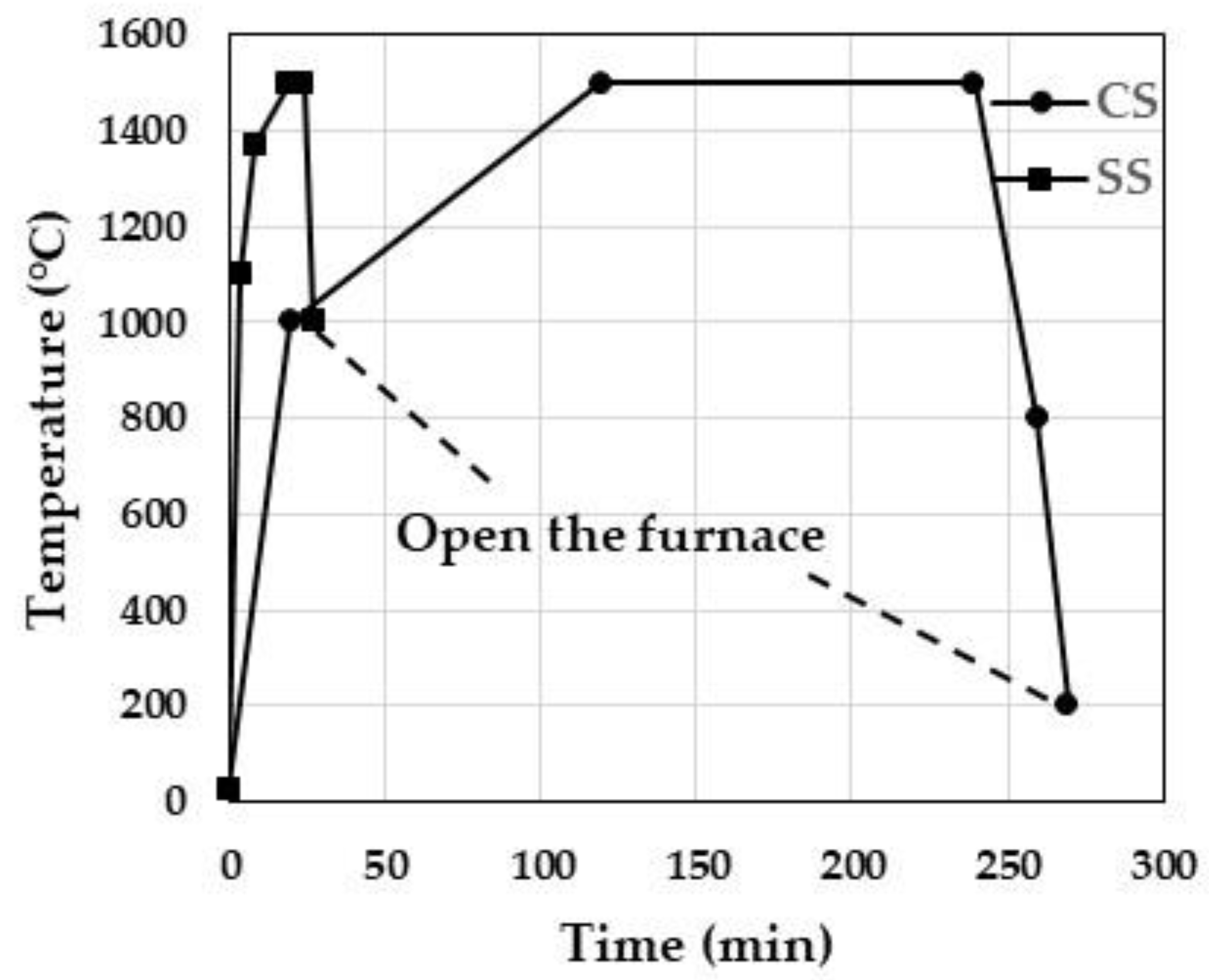

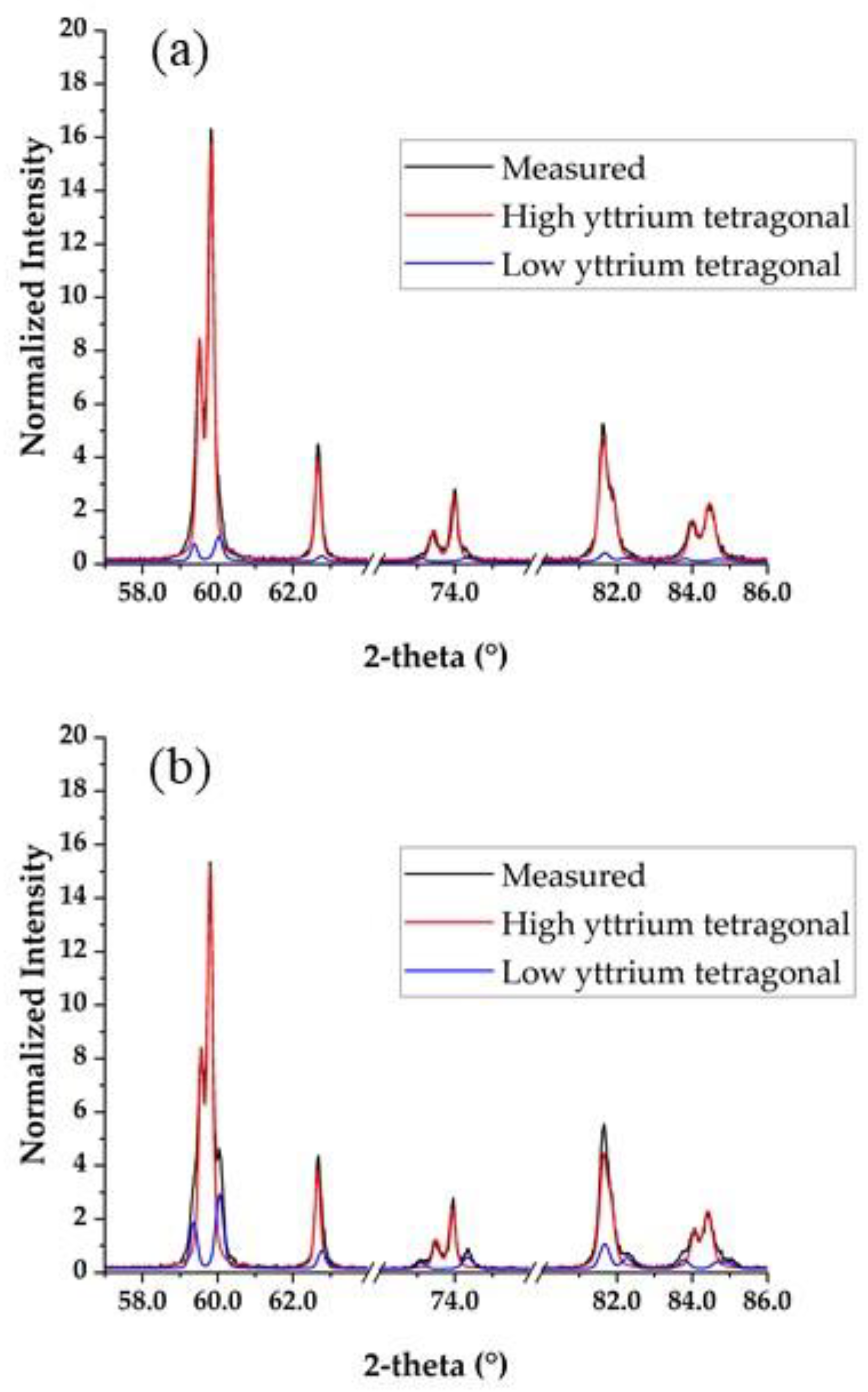


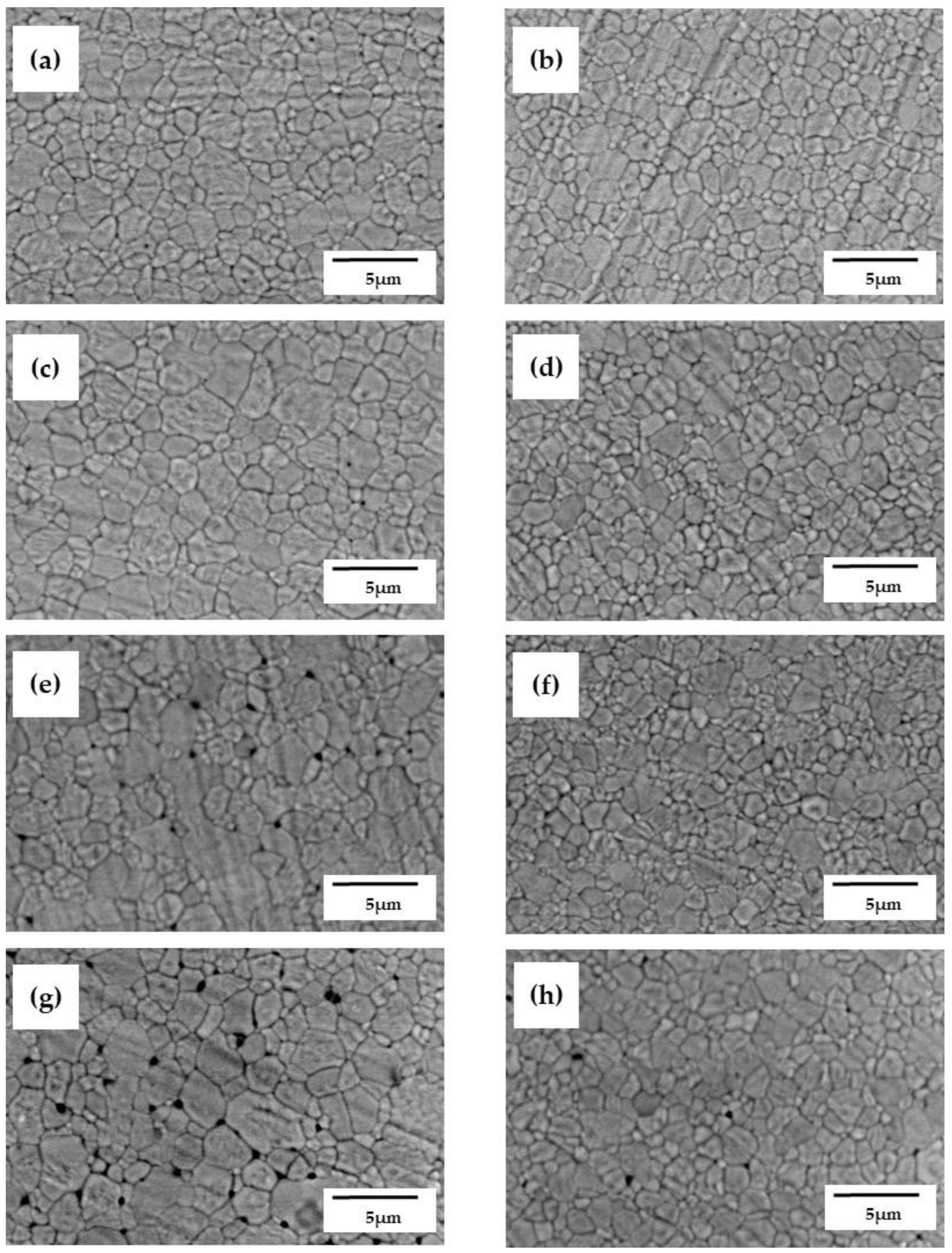
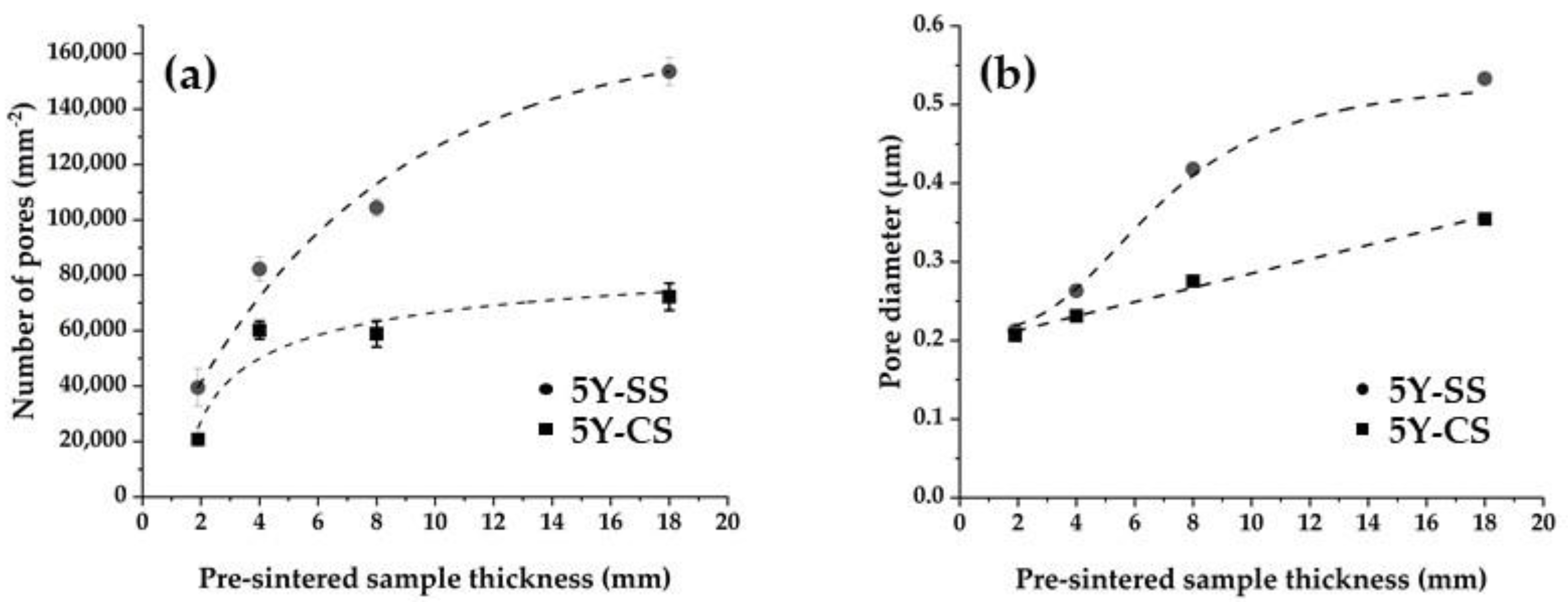
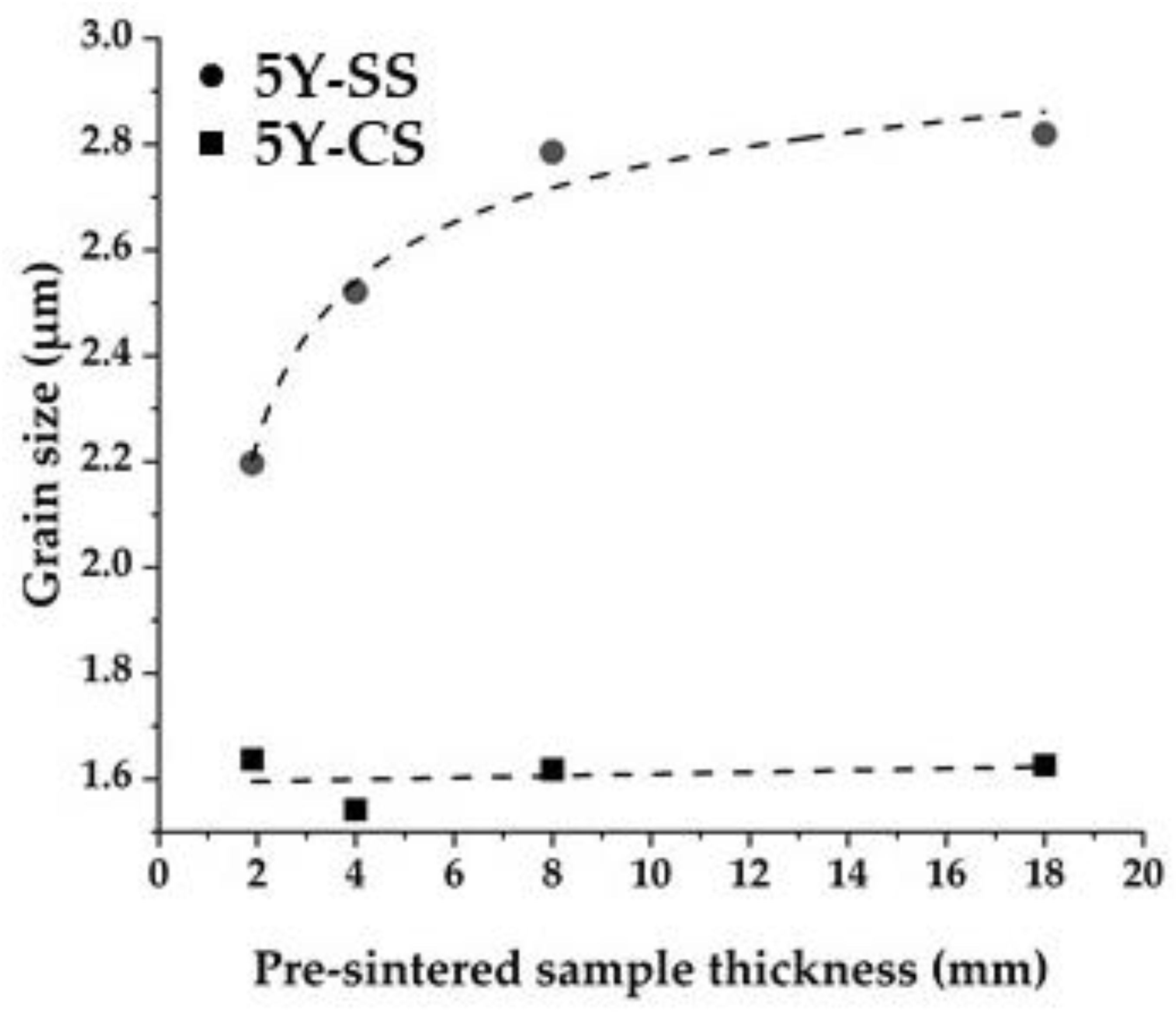

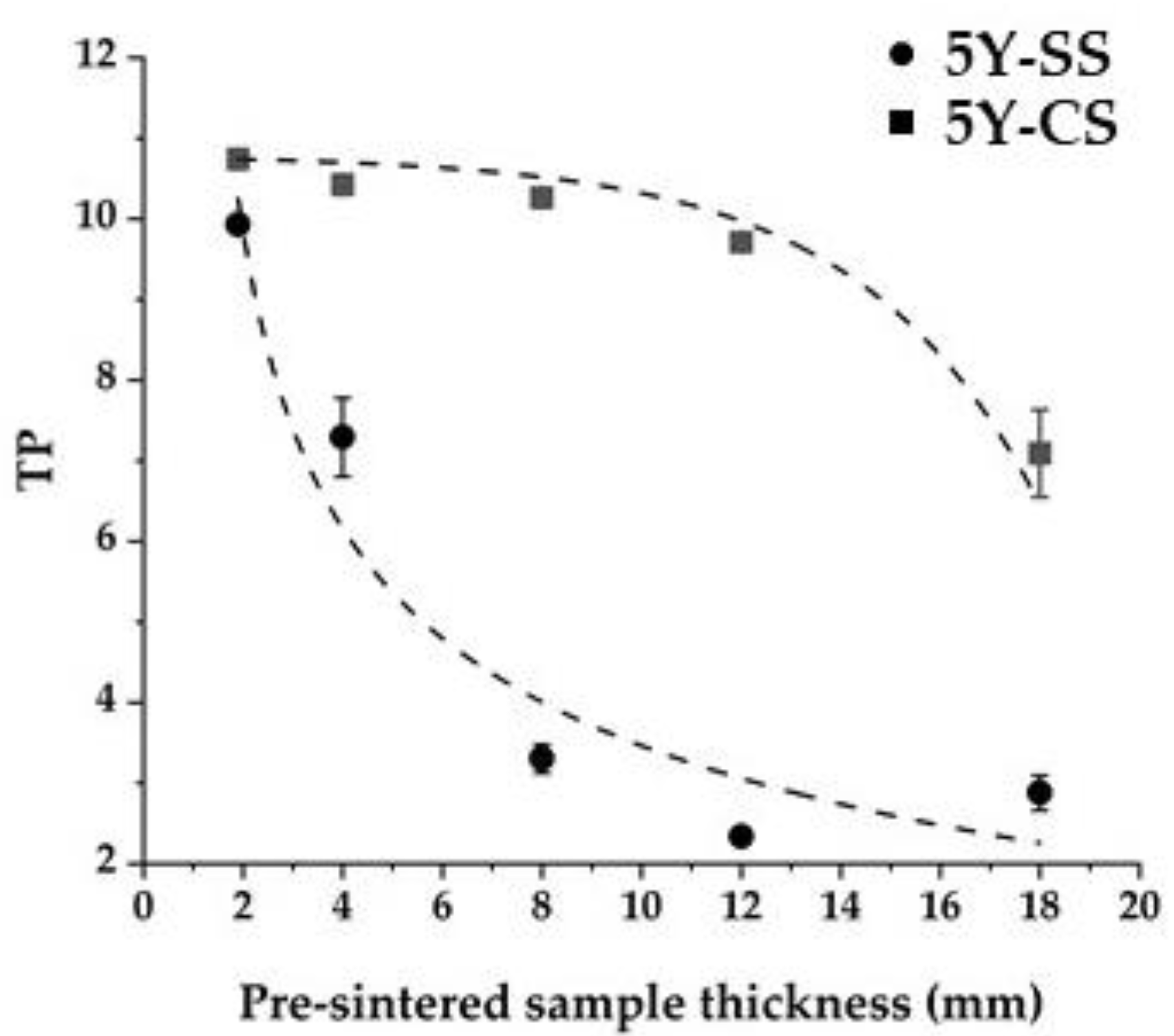
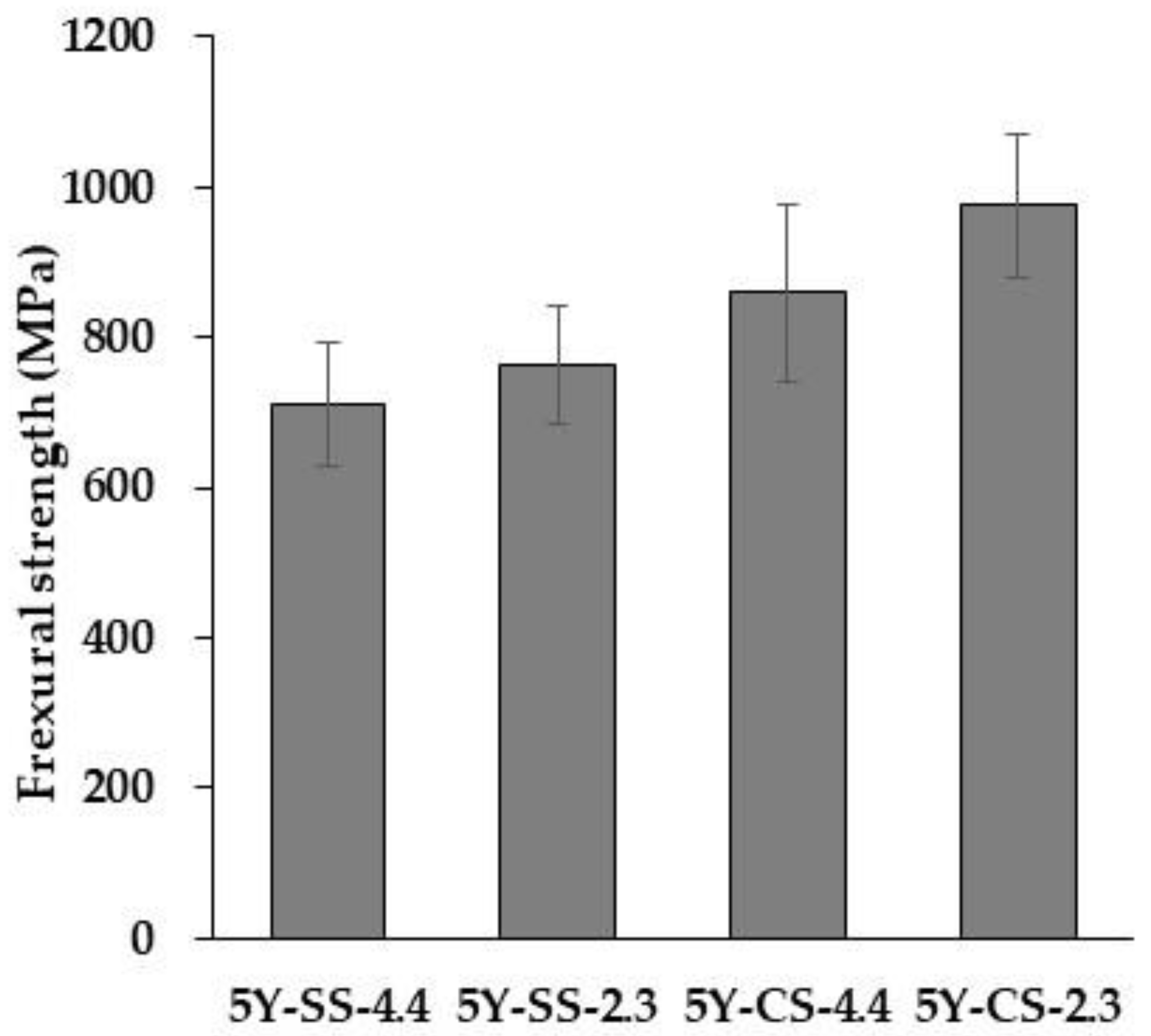
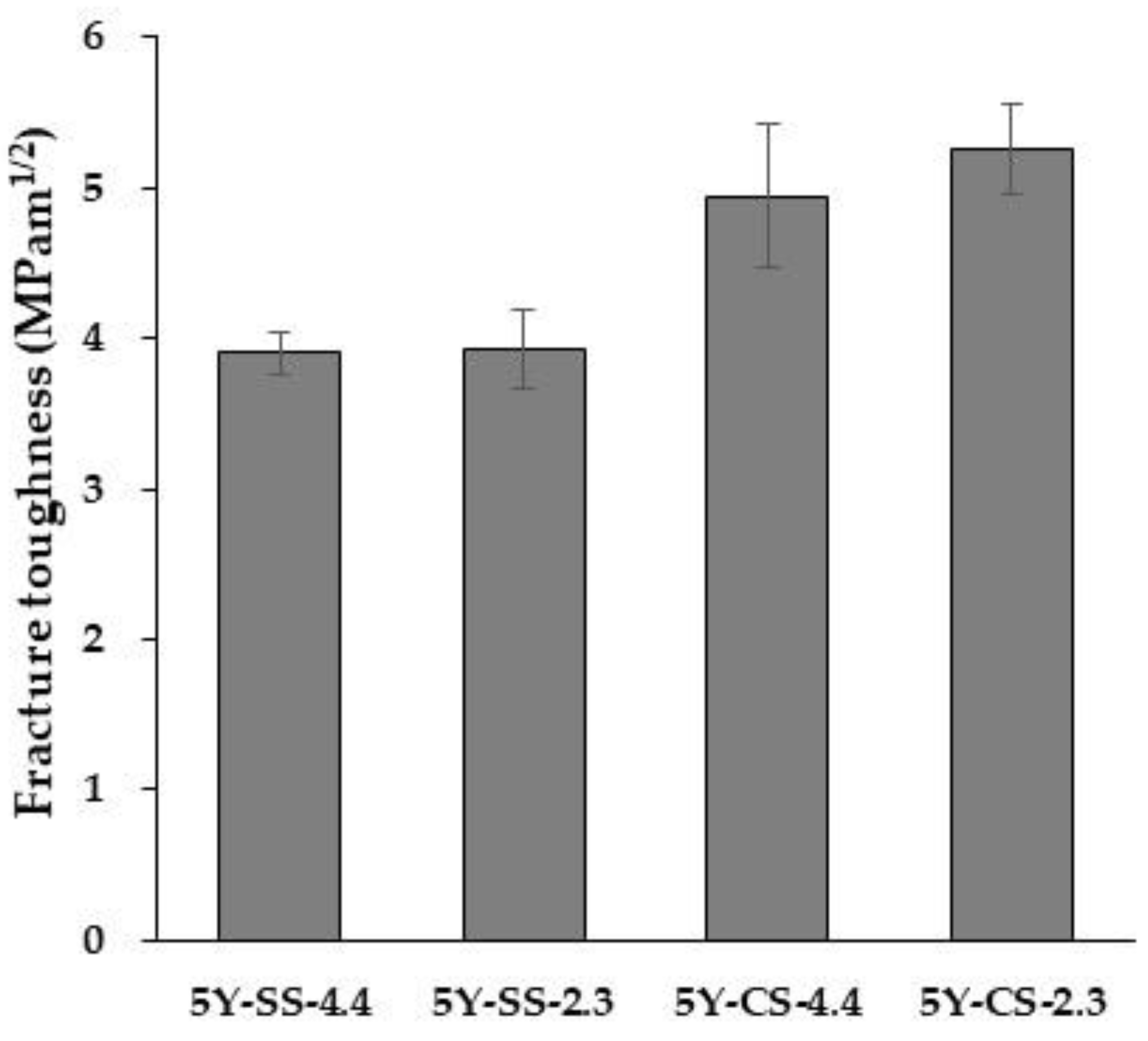
| Sample Name | Raw Material Powder | Chemical Composition (wt%) * | Sintering Method |
|---|---|---|---|
| 5Y-SS-×× | Zpex Smile | ZrO2: 88.84 Y2O3: 9.29 Al2O3: 0.049 HfO2: 1.82 | High-Speed |
| 5Y-CS-×× | Zpex Smile | Conventional |
| Measurement | Specimen Dimensions | |
|---|---|---|
| Before Sintering | At The Time of Measurement | |
| Density | φ18 mm × 18 mm | φ15 mm × 15 mm |
| XRD | φ18 mm × 1.9 mm and 18 mm | φ15 mm × 1.0 mm |
| SEM | φ18 mm × 1.9, 4.0, 8.0 and 18 mm | φ15 mm × 1.0 mm |
| Translucency | φ18 mm × 1.9, 4.0, 8.0, 12 and 18 mm | φ15 mm × 1.0 mm |
| Three-point flexural test | 20 mm (l) × 5.4 mm (w) × 2.3 mm (t) 20 mm (l) × 5.4 mm (w) × 4.4 mm (t) | 16 mm (l) × 4.0 mm (w) × 1.2 mm (t) |
| Fracture toughness test | 26 mm (l) × 5.4 mm (w) × 4.4 mm (t) 26 mm (l) × 5.4 mm (w) × 2.3 mm (t) | 20 mm (l) × 4.0 mm (w) × 3.0 mm (t) 20 mm (l) × 4.0 mm (w) × 1.5 mm (t) |
| 5Y-SS | 5Y-CS | Previous Report [19] | ||
|---|---|---|---|---|
| high yttrium tetragonal | tetragonality | 1.0063 | 1.0050 | - |
| Y2O3 (mol%) | 6.44 | 7.03 | 7.01–7.16 | |
| phase content ratio | 0.87 | 0.74 | 0.63–0.67 | |
| low yttrium tetragonal | tetragonality | 1.0137 | 1.0145 | - |
| Y2O3 (mol%) | 3.36 | 3.04 | 2.95–3.10 | |
| phase content ratio | 0.13 | 0.26 | 0.33–0.37 |
| Source | SS | df | MS | F | p | *: p < 0.05 **: p < 0.01 |
|---|---|---|---|---|---|---|
| Sintering method | 319,942.53 | 1 | 319,942.53 | 35.18 | <0.001 | ** |
| Specimen thickness | 70,205.46 | 1 | 70,205.46 | 7.72 | 0.0086 | ** |
| Sintering method * Specimen thickness | 10,055.90 | 1 | 10,055.90 | 1.11 | 0.3000 | |
| Error | 327,423.94 | 36 | 9095.11 | |||
| Total | 727,627.83 | 39 |
| Source | SS | df | MS | F | p | *: p < 0.05 **: p < 0.01 |
|---|---|---|---|---|---|---|
| Sintering method | 7.0615 | 1 | 7.0615 | 69.90 | <0.001 | ** |
| Specimen thickness | 0.1460 | 1 | 0.1460 | 1.44 | 0.2468 | |
| Sintering method * Specimen thickness | 0.1030 | 1 | 0.1030 | 1.02 | 0.3277 | |
| Error | 1.6165 | 16 | 0.1010 | |||
| Total | 8.9269 | 19 |
Publisher’s Note: MDPI stays neutral with regard to jurisdictional claims in published maps and institutional affiliations. |
© 2022 by the authors. Licensee MDPI, Basel, Switzerland. This article is an open access article distributed under the terms and conditions of the Creative Commons Attribution (CC BY) license (https://creativecommons.org/licenses/by/4.0/).
Share and Cite
Nonaka, K.; Teramae, M.; Pezzotti, G. Evaluation of the Effect of High-Speed Sintering and Specimen Thickness on the Properties of 5 mol% Yttria-Stabilized Dental Zirconia Sintered Bodies. Materials 2022, 15, 5685. https://doi.org/10.3390/ma15165685
Nonaka K, Teramae M, Pezzotti G. Evaluation of the Effect of High-Speed Sintering and Specimen Thickness on the Properties of 5 mol% Yttria-Stabilized Dental Zirconia Sintered Bodies. Materials. 2022; 15(16):5685. https://doi.org/10.3390/ma15165685
Chicago/Turabian StyleNonaka, Kazumichi, Mitsuji Teramae, and Giuseppe Pezzotti. 2022. "Evaluation of the Effect of High-Speed Sintering and Specimen Thickness on the Properties of 5 mol% Yttria-Stabilized Dental Zirconia Sintered Bodies" Materials 15, no. 16: 5685. https://doi.org/10.3390/ma15165685





